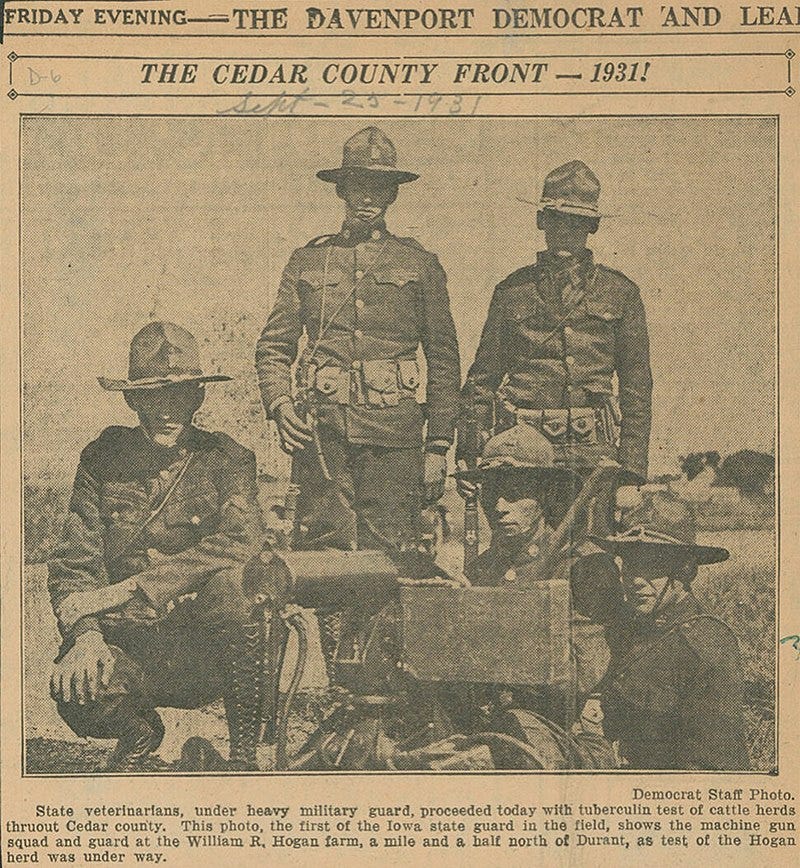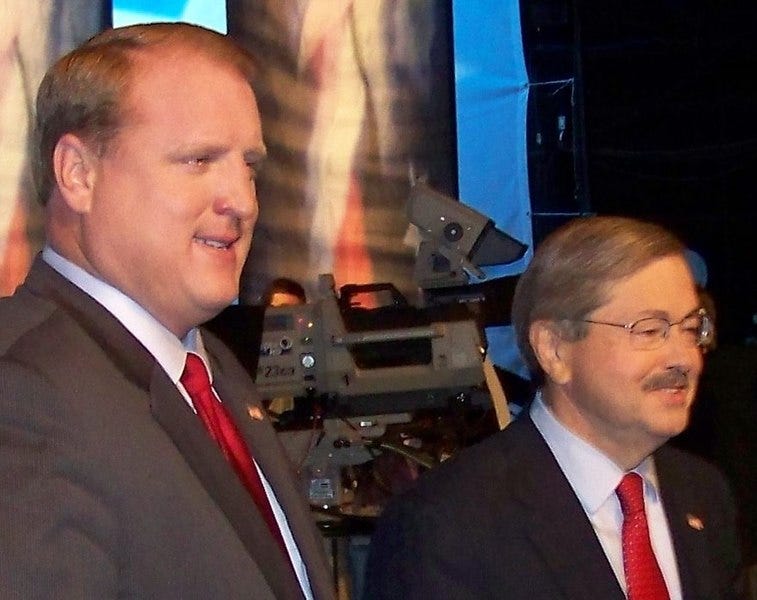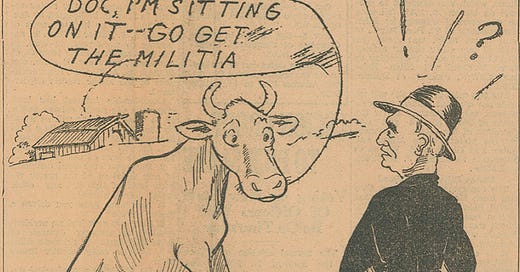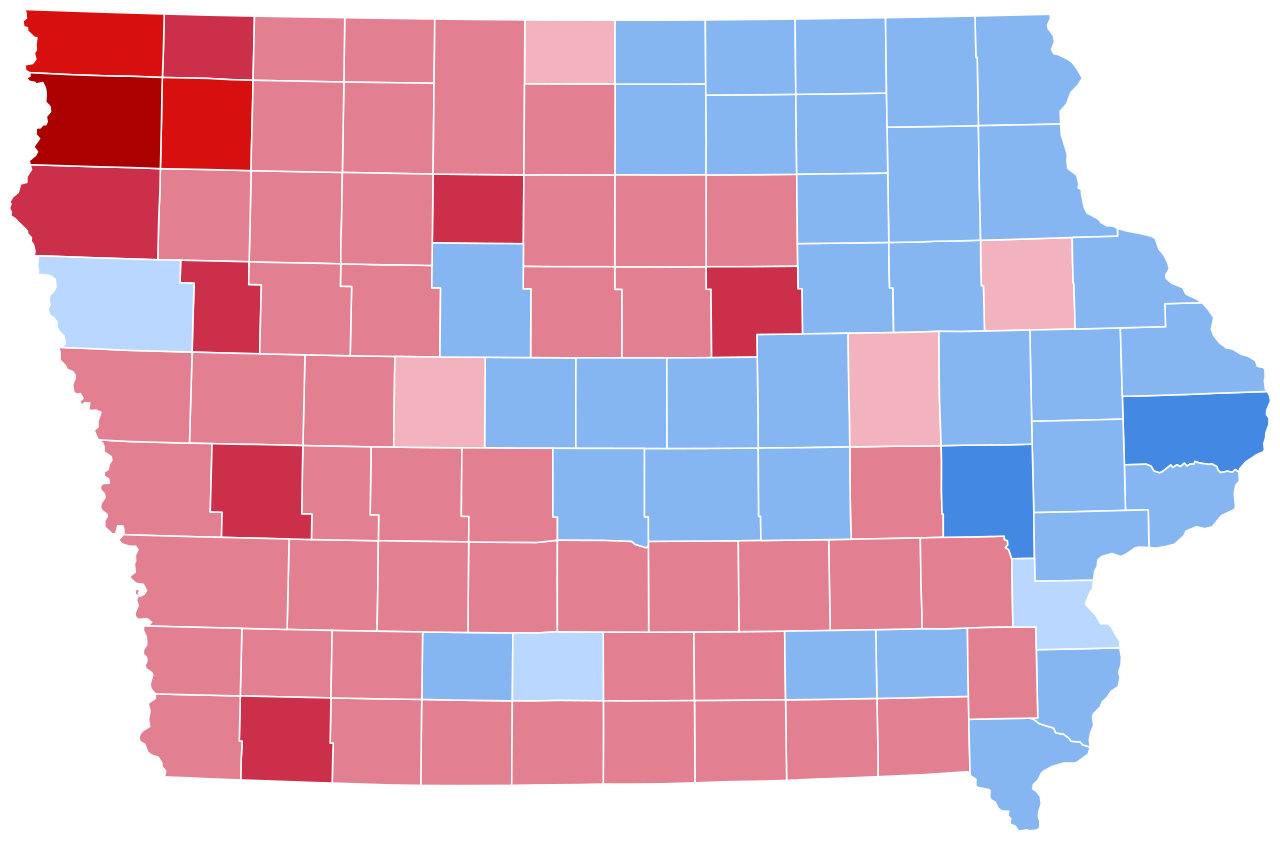"Iowa will go Democratic when Hell goes Methodist"
Analyzing the recent shift from purple to red Iowa and learn about the Iowa Cow War
"Iowa will go Democratic when Hell goes Methodist."
Iowa U.S. Senator Jonathan Dolliver (1958-1910)-Attributed
Growing up on the Missouri/Iowa border, I remember the 1990s when both states could be described as politically purple. It wasn’t uncommon for both Democrats and Republicans to hold statewide offices at the same time. Both states stayed politically purple up until recently. Today, both have moved far to the right.
To get a good picture of how rural America has moved, we can look to Iowa.
Donald Trump defeated Kamala Harris by 13.3% in this past Presidential election. How did a state that went from having the Democrats controlling the Governor’s office, both the House and the Senate, and giving their Presidential electors to Barack Obama twice go from the Republicans controlling all but one statewide or federal office?

It isn’t the first time politics in the state has shifted. Long before my run for Governor in 2018, another Porter ran for Iowa Governor. In 1906 and 1910, Claude Porter (no relation), was the first Democrat to come close to winning Iowa Governor since 1850, but he still lost both races by about four percent. A Democrat did not win the Governor’s seat again until 1932 when Clyde Herring defeated Republican incumbent Dan Turner.

Turner lost by a little over 5 percent in a year when Democrats made tremendous gains nationally during the Great Depression.
It also came on the heels of the Iowa Cow War. The state legislature had mandated bovine tuberculosis testing for all dairy and meat cows. Farmers were skeptical of the tests and according to research from Iowa State University, believed the tests could give cattle tuberculosis or cause spontaneous abortions. There were also constitutional arguments that the Iowa Supreme Court rejected.
In September 1931, Governor Turner deployed the National Guard to Cedar County to protect the veterinarians trying to test the cows.
This may have been enough to change public sentiment in the state to favor electing a Democrat as Governor.

From 1938 to 1956, Iowa went back to electing Republican Governors. Republican Governors Ray and Branstad served from 1968 to 1988 undefeated, but there is more to that story as Iowa elected Democratic Senator Tom Harkin in 1984 who served until retiring in 2014. Likewise, Michael Fitzgerald was elected to State Treasurer, a statewide office as a Democrat in 1982 until his defeat in 2022. Republican Senator Chuck Grassley was elected in 1980 and is still elected to that same office as I write this.
Iowa was a purple state for most of that period. Since 1980, Branstad became the longest-serving Governor in United States history and Fitzgerald is the longest-serving Treasurer in United States history.
At some point about 15 years ago, Iowa started to shift from purple to red. It happened suddenly and many politicians and political operatives such as me failed to predict it.
In 2006, I had just moved to Des Moines where I started business college. That year was a big year for the Democrats. Going into the election, the Iowa Senate was tied for members and Republicans had fifty-one of the Iowa House seats. In the end, Democrats had a five-seat majority in the Senate and an eight-vote majority in the House. Democrats elected Chet Culver, son of former U.S. Senator John Culver (1975-1981) in the open election for Iowa Governor.
Democrats had the trifecta. They held three out of the five Congressional seats. Republicans felt defeated.
Republicans were in a strong position in Iowa with the formation of the tea party. They brought in former Governor Terry Branstad to run against Chet Culver in 2010. Branstad was the longest-serving Governor in Iowa history. If anyone could defeat the Democrats, it was Branstad.

Branstad and the Republicans defeated incumbent Chet Culver by over 9% carrying most of the state.
Democrats keep three of the five Congressional seats but lost fourteen seats in the state house flipping majority to the Republicans and losing five seats in the Senate barely keeping the majority.
Democrats were hurt, but we didn’t know how bad.
2012 comes along and Iowa loses a Congressional seat after the 2010 census. This put incumbent Congressmen Leonard Boswell (D) and Tom Latham (R) into the same district. Latham moved to Boswell’s district to avoid running against Republican incumbent Steve King. Latham defeated Boswell by 9 percent.
Democrats pick up seven seats in the state house getting them closer to the majority and maintain their seats in the state senate.
Barrack Obama defeated Mitt Romney in the state by about 5%. Democrats are still in this game.
2014 was a bad year for the Iowa Democrats and here is where we see the shift from purple to red hit hard.
Senator Harkin has retired, and the U.S. Senate seat is hotly contested. State Senator Joni Ernst easily wins the Republican primary with her hog castration TV ad “Make Em Squeal” to face Democratic Congressman Bruce Braley. Polls have the race extremely close, and no one knows what will happen, but most people believe it will be close.
Democrat Braley is hit hard over comments on towel service and farmers.
Days before the election, the Des Moines Register poll comes out with Ernst leading by 7 points. Many believe this poll to be an outlier and pollster Ann Seltzer receives criticism. Ernst wins by over 8%.
The Democratic Governor nominee State Senator Jack Hatch lost to incumbent Governor Branstad by 21 percent which did not help the down ticket.
Republicans pick up four seats in the state house and the state senate remained the same.
In 2016, Trump beats Clinton by 6% in the state and Republicans pick up two seats in the House and picked up six seats in the Senate giving them the trifecta.
In 2018, the Democrats make a short-lived comeback. Republican Governor Branstad accepts a position as Ambassador to China leaving LT Governor Kim Reynolds to face businessman Fred Hubble (and me!) for the open seat. Reynolds only wins by 3% and Democrats pick up two Congressional seats.
Democrats pick up five seats in the house and Republicans picked up three seats in the senate.
In 2020, the Democrats lose six seats in the house and no change occurs in the senate. Democratic incumbent Congressman Dave Loebsack retires and is Replaced by Mariannette Miller Meeks who wins by only six votes. They also lost Iowa’s first Congressional District.
In 2022, the shift from purple to red is complete when Democrats lose another incumbent Congressional seat. The longest serving State Treasurer in United States history, Democrat Michael Fitzgerald and the long-serving Attorney General Tom Miller are defeated. Only one statewide candidate, State Auditor Rob Sand, remains in power and Republicans control all federal offices.
The Democrats lost Iowa. They lost with the tea party in 2010, the lost by not contesting the 2014 elections well enough, and they lost with COVID (just like the Republicans lost with the Cow War over similar issues 90 years prior). They were able to make a comeback in 2018 when Trump was not on a ballot, but in 2022 they lost horribly.
If Democrats don’t find a way to talk to Iowans and campaign effectively, they may be stuck in this cycle until hell goes Methodist.






